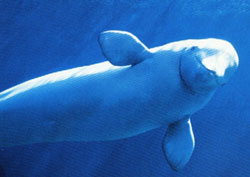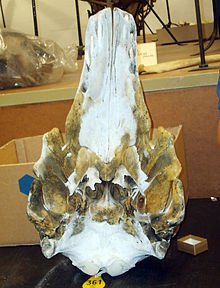
Whales(Balaena) are a widely distributed and diverse group of fully aquatic placental marine mammals. As an informal and colloquial grouping, they correspond to large members of the infraorder Cetacea, i.e. all cetaceans apart from dolphins and porpoises. Dolphins and porpoises may be considered whales from a formal, cladistic perspective. Whales, dolphins and porpoises belong to the order Cetartiodactyla, which consists of even-toed ungulates. Their closest non-cetacean living relatives are the hippopotamuses, from which they and other cetaceans diverged about 54 million years ago. The two parvorders of whales, baleen whales (Mysticeti) and toothed whales (Odontoceti), are thought to have had their last common ancestor around 34 million years ago. Mysticetes include four extant (living) families: Balaenopteridae, Balaenidae, Cetotheriidae, and Eschrichtiidae. Odontocetes include the Monodontidae, Physeteridae, Kogiidae, and Ziphiidae, as well as the six families of dolphins and porpoises which are not considered whales in the informal sense.

The narwhal, also known as the narwhale, is a species of toothed whale. It is a member of the family Monodontidae, and the only species in the genus Monodon. Adults are typically 3.5 to 5.5 m in length and 800 to 1,600 kg in weight. The most prominent feature of the species is an adult male's long single tusk that can be up to 3 m (9.8 ft). Instead of a dorsal fin, narwhals possess a shallow dorsal ridge. They are gregarious animals, and may associate in groups of up to 20 members. Carl Linnaeus scientifically described the species in 1758 in his work Systema Naturae.

The beluga whale is an Arctic and sub-Arctic cetacean. It is one of two members of the family Monodontidae, along with the narwhal, and the only member of the genus Delphinapterus. It is also known as the white whale, as it is the only cetacean to regularly occur with this colour; the sea canary, due to its high-pitched calls; and the melonhead, though that more commonly refers to the melon-headed whale, which is an oceanic dolphin.

The cetacean family Monodontidae comprises two living whale species, the narwhal and the beluga whale and at least four extinct species, known from the fossil record. Beluga and Narwhal are native to coastal regions and pack ice around the Arctic Ocean. Both species are relatively small whales, between three and five metres in length, with a forehead melon, and a short or absent snout. They do not have a true dorsal fin, but do have a narrow ridge running along the back, which is much more pronounced in the narwhal. They are highly vocal animals, communicating with a wide range of sounds. Like other whales, they also use echolocation to navigate. Belugas can be found in the far north of the Atlantic and Pacific Oceans; the distribution of narwhals is restricted to the Arctic and Atlantic Oceans.
In biology, a monotypic taxon is a taxonomic group (taxon) that contains only one immediately subordinate taxon. A monotypic species is one that does not include subspecies or smaller, infraspecific taxa. In the case of genera, the term "unispecific" or "monospecific" is sometimes preferred. In botanical nomenclature, a monotypic genus is a genus in the special case where a genus and a single species are simultaneously described. In contrast, an oligotypic taxon contains more than one but only a very few subordinate taxa.

The false killer whale is a species of oceanic dolphin that is the only extant representative of the genus Pseudorca. It is found in oceans worldwide but mainly in tropical regions. It was first described in 1846 as a species of porpoise based on a skull, which was revised when the first carcasses were observed in 1861. The name "false killer whale" comes from having a skull similar to the orca, or killer whale.

Lagenorhynchus is a genus of oceanic dolphins in the infraorder Cetacea, presently containing six extant species. However, there is consistent molecular evidence that the genus is polyphyletic and several of the species are likely to be moved to other genera. In addition, the extinct species Lagenorhynchus harmatuki is also classified in this genus.

Whales use a variety of sounds for communication and sensation. The mechanisms used to produce sound vary from one family of cetaceans to another. Marine mammals, including whales, dolphins, and porpoises, are much more dependent on sound than land mammals due to the limited effectiveness of other senses in water. Sight is less effective for marine mammals because of the particulate way in which the ocean scatters light. Smell is also limited, as molecules diffuse more slowly in water than in air, which makes smelling less effective. However, the speed of sound is roughly four times greater in water than in the atmosphere at sea level. As sea mammals are so dependent on hearing to communicate and feed, environmentalists and cetologists are concerned that they are being harmed by the increased ambient noise in the world's oceans caused by ships, sonar and marine seismic surveys.
The Cumberland Sound belugas are a distinct population of belugas residing in the Cumberland Sound region of the Labrador Sea off the coast of Nunavut, Canada Individuals of this population reside in the sound year-round, congregating in its extreme north exclusively at Clearwater Fjord during the summer for calving. The Cumberland Sound beluga population is considered fairly isolated and genetically distinct from other beluga populations, with a notable number of haplotypes and microsatellite loci not found elsewhere.

Muktuk is a traditional food of the peoples of the Arctic, consisting of whale skin and blubber. It is most often made from the bowhead whale, although the beluga and the narwhal are also used. It is usually consumed raw, but can also be eaten frozen, cooked, or pickled.

NOC was a beluga whale who made human-like vocalizations. He was captured by Inuit hunters for the United States Navy in 1977 and lived in captivity until his death in 1999. In 1984, researchers from the National Marine Mammal Foundation discovered his unusual ability to mimic the rhythm and tone of human speech. Belugas' human-like voices had been described in the past, but NOC's voice was the first to have been recorded.

Christine Erbe is a German-Australian physicist specializing in underwater acoustics. She is a professor in the School of Earth and Planetary Sciences and director of the Centre for Marine Science and Technology (CMST)—both at Curtin University in Perth, Western Australia, Australia. Erbe is known for her research on acoustic masking in marine mammals, investigating how man-made underwater noise interferes with animal acoustic communication.

Sue E. Moore is a scientist at the University of Washington known for her research on marine mammals in the Arctic.
Annemarie Surlykke was a Danish physiologist. She contributed significantly to bioacoustic research, in particular in the fields of insect hearing and acoustic communication, bat echolocation and insect-bat interactions. Graduated from University of Southern Denmark, employments at University of Tübingen and Aarhus University. From 1987 associate professor at University of Southern Denmark, full professor in 2011.












